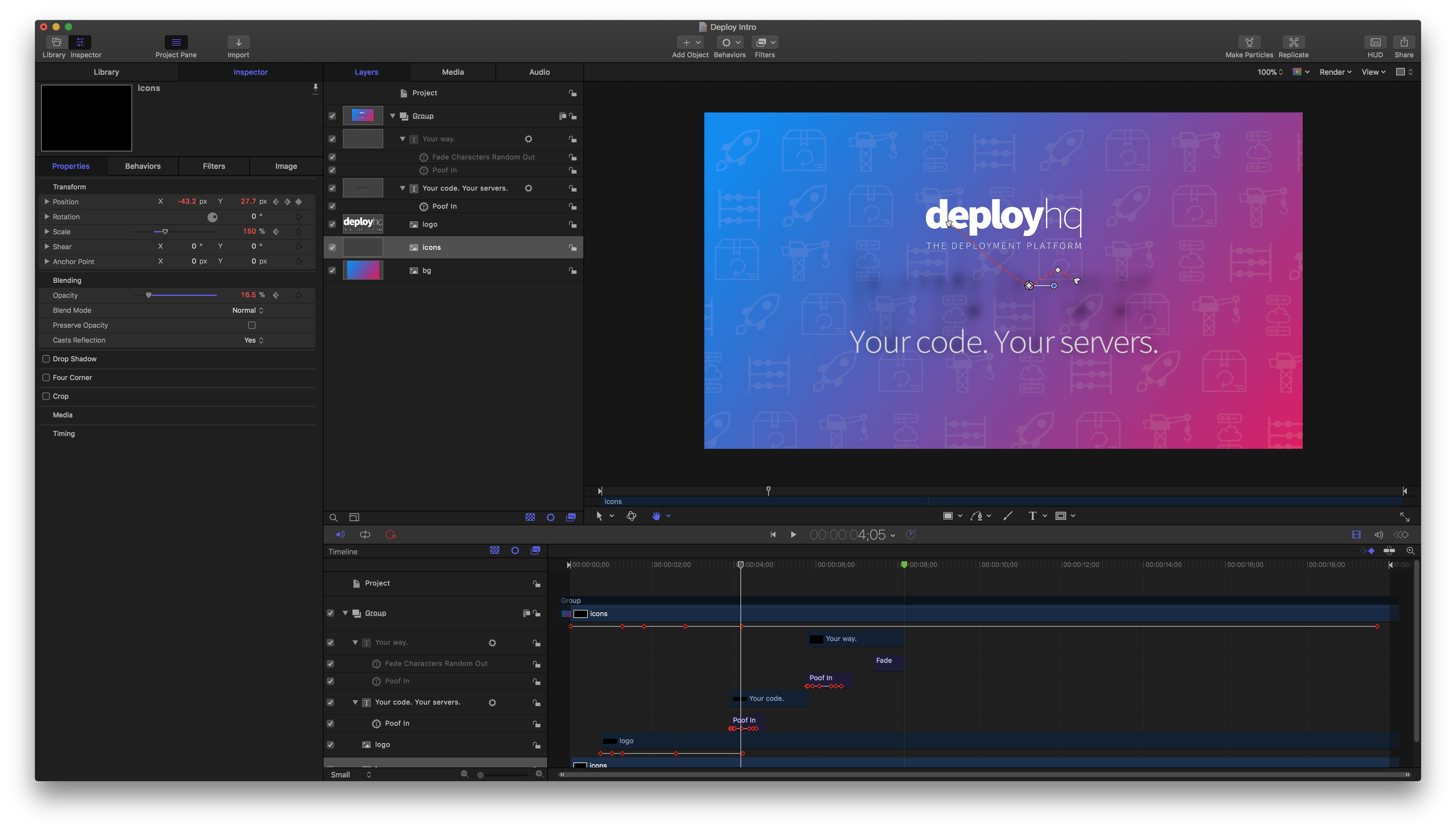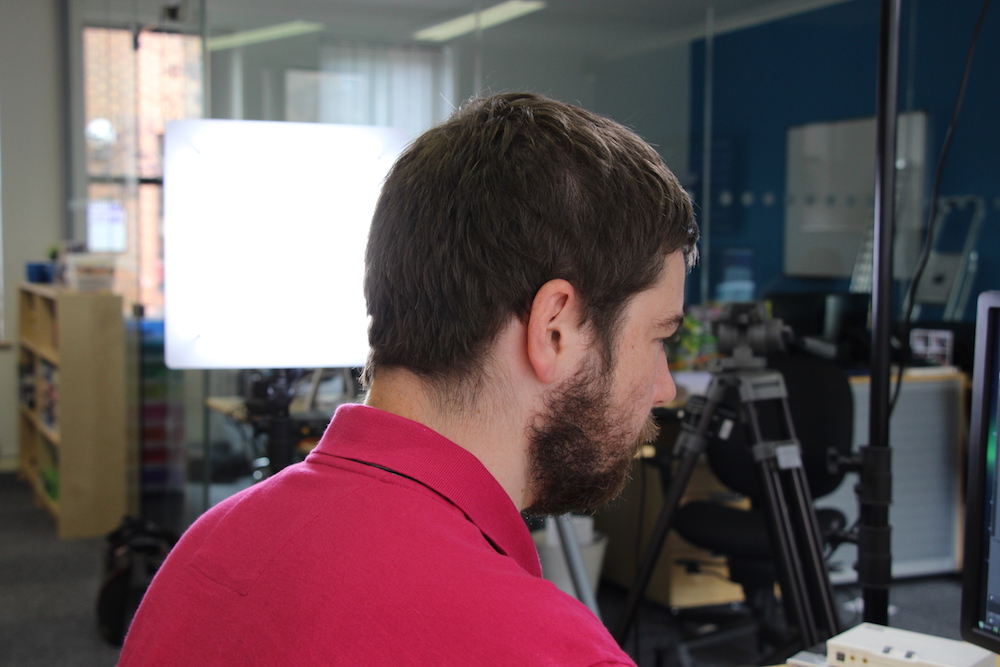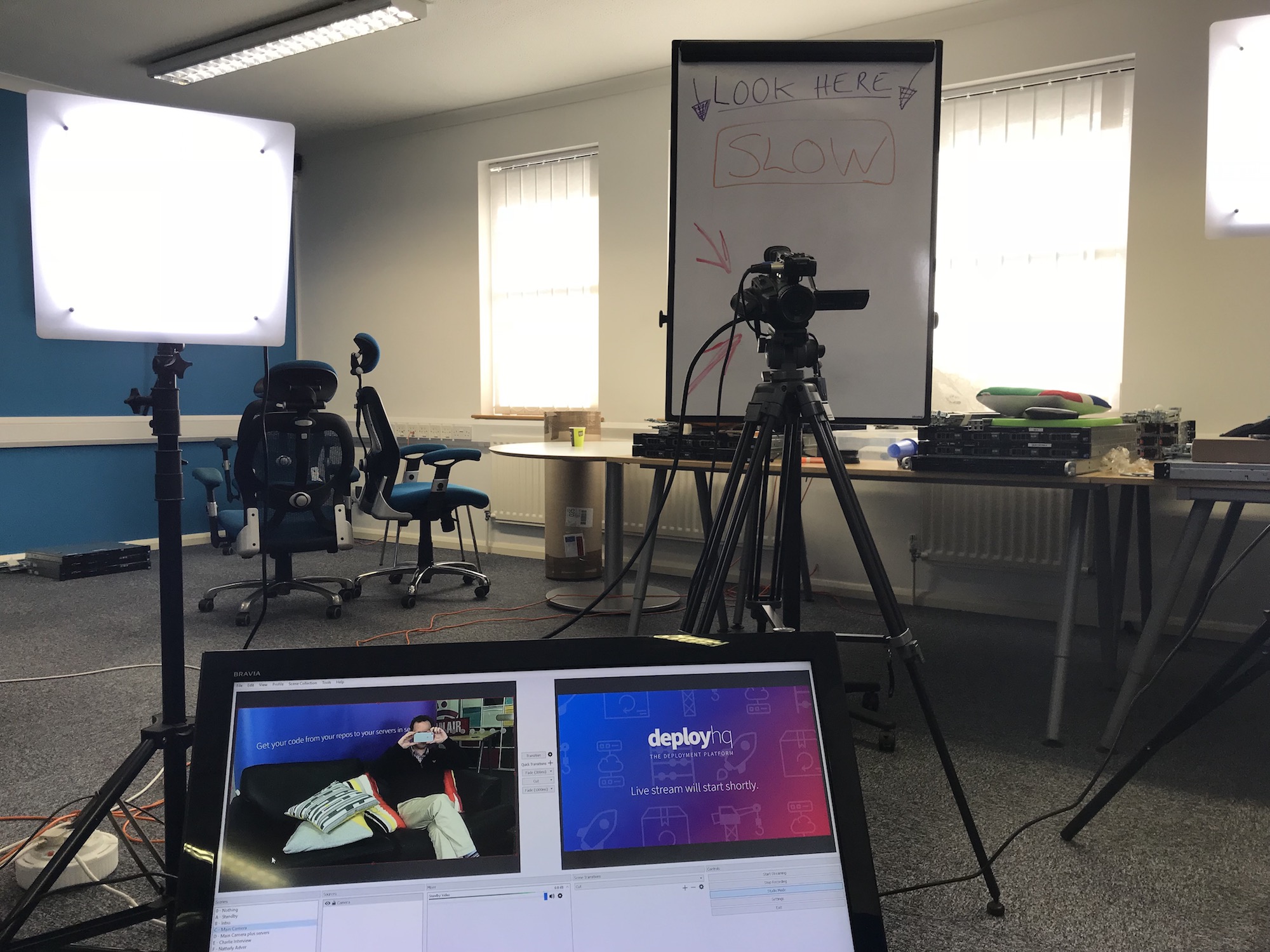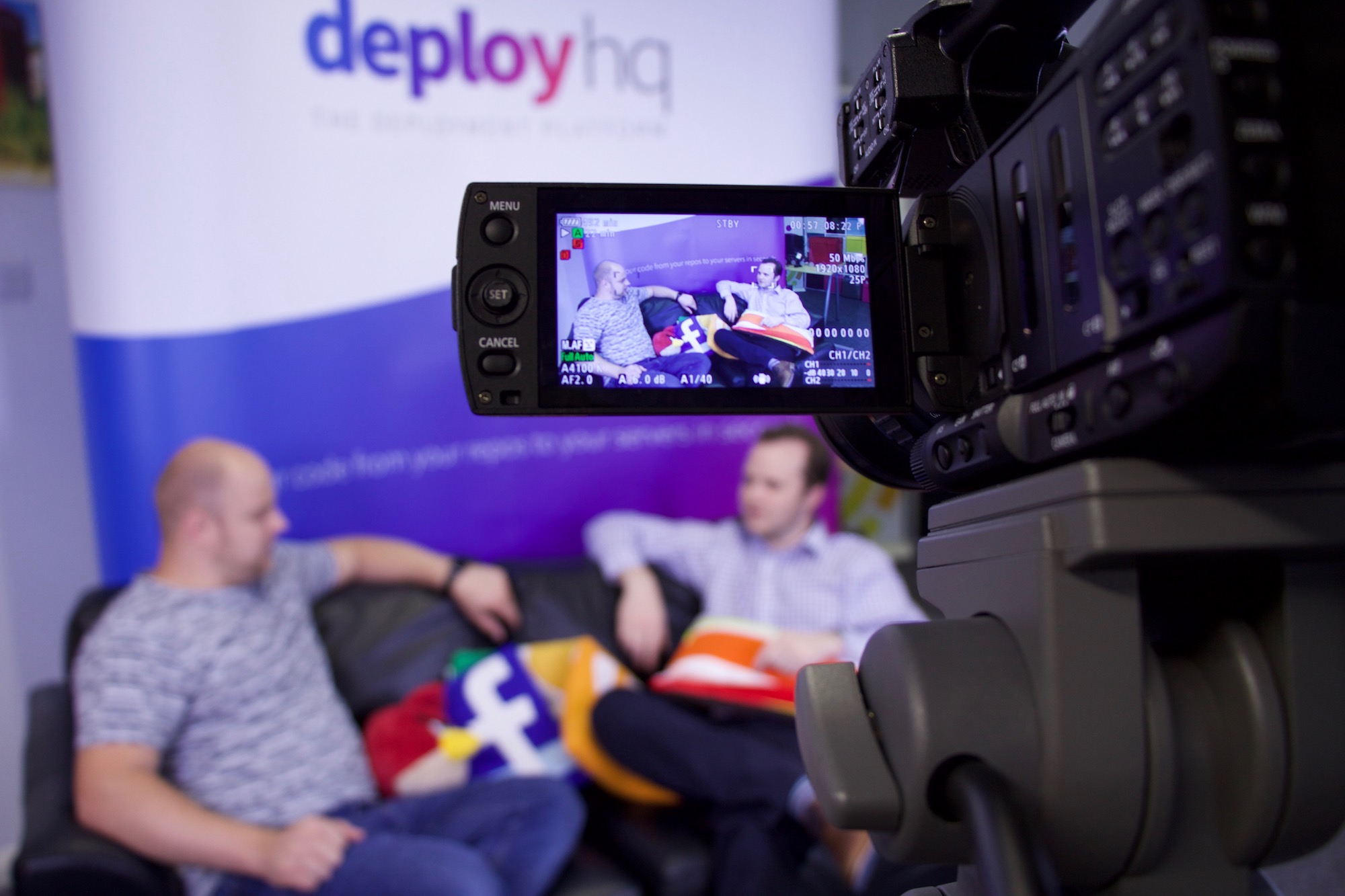Back at the start of September we thought it would be fun to live stream the launch of our new UI. It was just going to be a Youtube Live feed from a mobile camera that we could walk around the office with. However, we realised this might be a little dull for viewers and wanted to construct something a little more, shall we say, entertaining.
Unfortunately, we only came to this conclusion on the Monday afternoon of the week in which we had scheduled our live stream to start on Thursday at 11.30am. Panic stations! There was lots of things to do and lots of things to acquire in order to get things ready.
Building an intro video
The first thing I needed was a short clip that could be added to the start of each video. Something we can use in the future at the start of every DeployHQ video we make and something that can be used throughout the live stream. I cracked out Motion, a program I haven't used for many years, and began to have a play.
The first thing that strikes me about Motion is that, despite having a pretty well spec'd iMac (4GHz i7, 16GB RAM), it can run extremely badly! I don't think I've ever seen so many beach balls in such a short period of time.
Anyway, I went ahead and built some assets in Sketch and exported them all ready for use in Motion. This intro clip should also include any sounds which are needed like the whooshing so these are embedded into the final export too.

This whole process took about an hour and a half. Next up, a little video for the homepage of the website that shows the new deployment process.
Building a UI demo video
The DeployHQ website has always had a little video which shows the deployment process in a video lasting less than a minute. With the new design, we needed a replacement for this and it needed building. Another job for Motion but, this time with the help of the QuickTime Player screen recording tools. When making the screencasts, I recorded them on a retina screen and made the browser size as large as possible to ensure the best quality recording.
I recorded lots of little sections of the deployment process into mov files and then imported these into Motion. Using keyframes I adjusted positioning & scale of the background screencast and added a mouse cursor along with sound effects and click actions.
I also needed to find some music and get this in. My usual source for royalty free music, Audio Jungle, came through and had something suitably upbeat so I bought a licence for this and I was on my way.
All a little bit fiddly but after a fair amount of beach-balling and frustration, I got there and this was the end result:
A bit of planning & concept testing
With just over 48 hours to go, we need to start writing a running order for the live stream show and we've got 30 minutes to fill. I decide that the live stream is going to be a series of live links which introduce a number of pre-recorded videos. After nobody volunteers to be the presenter, I realise that this role is going to be falling to me. Not only am I going to be trying to produce this thing, I'm also going to be in front of the camera - not a place I have any experience! "Oh well", I think, "maybe it'll be so bad, it'll be good!"
The first order of business is to work out if this is even going to be possible. How are we going to stream this? Where are we going to stream to? How do you mix together live & pre-recorded videos in realtime?
Fortunately, the answers to all these questions were quite easily answered. Rob piped up about a piece of software called OBS Studio which is an open source piece of software favoured by live streamers all over the world. I downloaded this and started to play, it's great and allowed us to do everything we could possibly desire.
The only thing we couldn't do was get the live output from our camera into the computer. We'd need some sort of HDMI capture card and with a rather limited time frame, ordering one and hoping for a quick delivery was a risk. I decided to commit one of the cardinal sins of being a nerd, I went to Maplin. I bought the Elgato Game Capture HD 60S which looked like it would do everything we needed (and it did).
Building more videos
More videos were now needed. We needed interviews with the team, we needed a few adverts for other products, a series of countdowns as well as a video to show off the new DeployHQ website.
The easiest of these was the video of the new website. This was very crudely put together using iMovie and with the help of a gentleman called Ken. I just took a load of screenshots of the new site, mixed them together with some cross dissolve transitions, popped the new intro at the front and added some music. Took about 30 minutes - ideal!
The adverts were very quick too. The Dial 9 advert was built in a hurry at 8am on the morning of the broadcast and Natterly was done at 8pm the night before. They're not going to be winning any awards and, to be honest, look very Powerpoint-y but they served their purpose.
The countdowns and other videos were another job for Motion and I learnt a fair amount building these. The main countdown would be shown towards the end of the stream and would have a BBC News 24 style 60 second countdown to launch.
We also needed a few other little clips like a "stream will be starting soon" and "thank you for watching". These were easy - I just made a very simple template I could use that panned the background slowly across the screen and updated the text.
Finally, we needed a main title video. I didn't have time to do anything very impressive here so I ended up just cycling through a "pre-launch" sequence of increasingly bizarre tasks.
Interviews
Interviewing people is hard unless you're a pro. I am not a pro. I always knew I needed to interview the key stakeholders in the project - Charlie, Dan, Batman, Rob & Ben but didn't really know how on earth to approach this.
On the Wednesday before, I lugged a huge quantity of equipment (cameras, lights, radio mics, etc...) down the stairs from our make shift studio and set it up at Batman's desk. Without a concrete plan, I then proceeded to just ask him some rather simple & random questions about DeployHQ. To my surprise, it went quite well and was all recorded in the first, single, take! Colour me impressed - he was quite a natural.

I then moved onto Charlie. Moved all the stuff to his desk and began with the questions. Rather unfortunately, the first thing I told him before we started recording was "don't look directly at the camera" - I thought that sounded like the sort of thing pros said. That was a mistake. He looked ridiculous. My bad. Anyway, no time to worry about that, we pressed on and got the second interview "in the can".
Next, Dan, an easy one as I just needed to swivel the camera around from Charlie's desk to his. We got through the interview quite easily but only once we finished did I notice the mess that was on display in the background behind him. Oh well, no time to re-record, we'll just have to cope with that and make sure it doesn't happen again.
Finally, Rob & Ben. Unlike the others, I wanted to do this with them on sofa, or the casting couch as they both called it, because I thought it might be a little more relaxed. In reality, it was probably too relaxed and it took at least 6 takes to get this recorded successfully. Rob's phone rang, nobody could get their words out and it was a bit of a shambles but perseverance prevailed and we got there in the end.
Once these were all ready, they just needed the intro adding in Final Cut and exporting ready for us. Took about 20 minutes for the lot - woo!
Setting up the "studio"

We already had most of the equipment we needed for our studio and I set this up upstairs away from noise and distractions. The key equipment in our studio was:
- A Canon XF100 camera
- 3x LED panel studio lights
- 2x Sennheiser Radio microphones
- A high-spec Windows PC running OBS
- A large TV pointed at me - so I could see what was coming next and know when I was live.
- A whiteboard to act as a make-shift auto cue - a last minute addition to remind me to look at the camera and to talk slowly!
Getting ready to go live
Now I had all the material I needed for the show and the studio was set up, I needed to put it together into a coherent running order. I got all the interviews into a suitable order interspersed with the other preview videos I'd made and then loaded it all into OBS.
I conscripted Dan Q as my vision mixer and gave him a copy of my provision running order, sat him in front of my OBS computer and then took my place on the sofa for the first run-through. The first run through was a successful disaster. While it would have been terrible if this had been the final output, it gave me a good idea of what I needed to do and focus my efforts on.
As I didn't have any sort of script or autocue, all the links were going to be made up on the spot. For this reason, I wanted to keep them short and to the point. I wrote down a number of things I wanted to speak about in each link and put this on my running order and reviewed this throughly just before it started.
We did about 5 full run throughs in the end, the last being about 30 minutes before we went live at 11.30.
Going live
At 11:15 we started the stream and were outputting the "stream will start shortly" video I'd made two days earlier. Until this point, I hadn't really been very nervous but these nerves certainly started to build in the 15 minutes prior to going live. I gave myself a few minutes to sit on the sofa and think about the first link - probably the most complex. I was going to be talking about our servers and had come up with an idea to show them live on the screen next to me and then cut back to just me before introducing the interview with Charlie.
The start went as well as I could have hoped really. I was a bit shouty right at the start but managed to get that under control quite quickly.
The moments while videos were playing were great and gave me an opportunity to think about what was coming next. That was until Charlie decided to pop his head around the door and started fiddling with my studio! Rather than focusing on what was coming next, I was focussed on what he was doing and suddenly realised I was going to be live again in 10 seconds. Charlie was silenced but I still had no idea what was coming next and what I was meant to be talking about. This was probably the worst link of the show - sorry - I guess Charlie needed to get me back for the mistakes in the filming of his own interview.

Afterwards
In the end, I was quite happy with the result and in just 3 days I had put together something that wasn't awful. Having said that, it wasn't perfect and there are a number of things I've learnt from this and things I'll be improving on next time.
All our microphone audio was routed through the camera which meant we had no real control or visibility of microphone levels during the live show. Next time, we'll be mixing this externally.
A single camera led to a rather boring selection of live links. Next time, we'll look at introducing a second camera into the studio.
The black sofa is ugly. Next time, we'll find a much more attractive set. Perhaps we'll invest in a green screen and broadcast live from Hawaii or from the Sahara Desert, you'll have to check out our next stream to find out.
There was no script - this meant the link content wasn't as well considered as I would have liked. With more time to prepare and practice I think this would have been less of an issue but next time I'll be sure to make sure it's more polished.
I hope this post has given you a bit of an insight into how I went about organising our live stream. If your business is looking to "go live" for an event, I'd love to help out and this is an area I now have a big interest so it would be great to hear from you.
